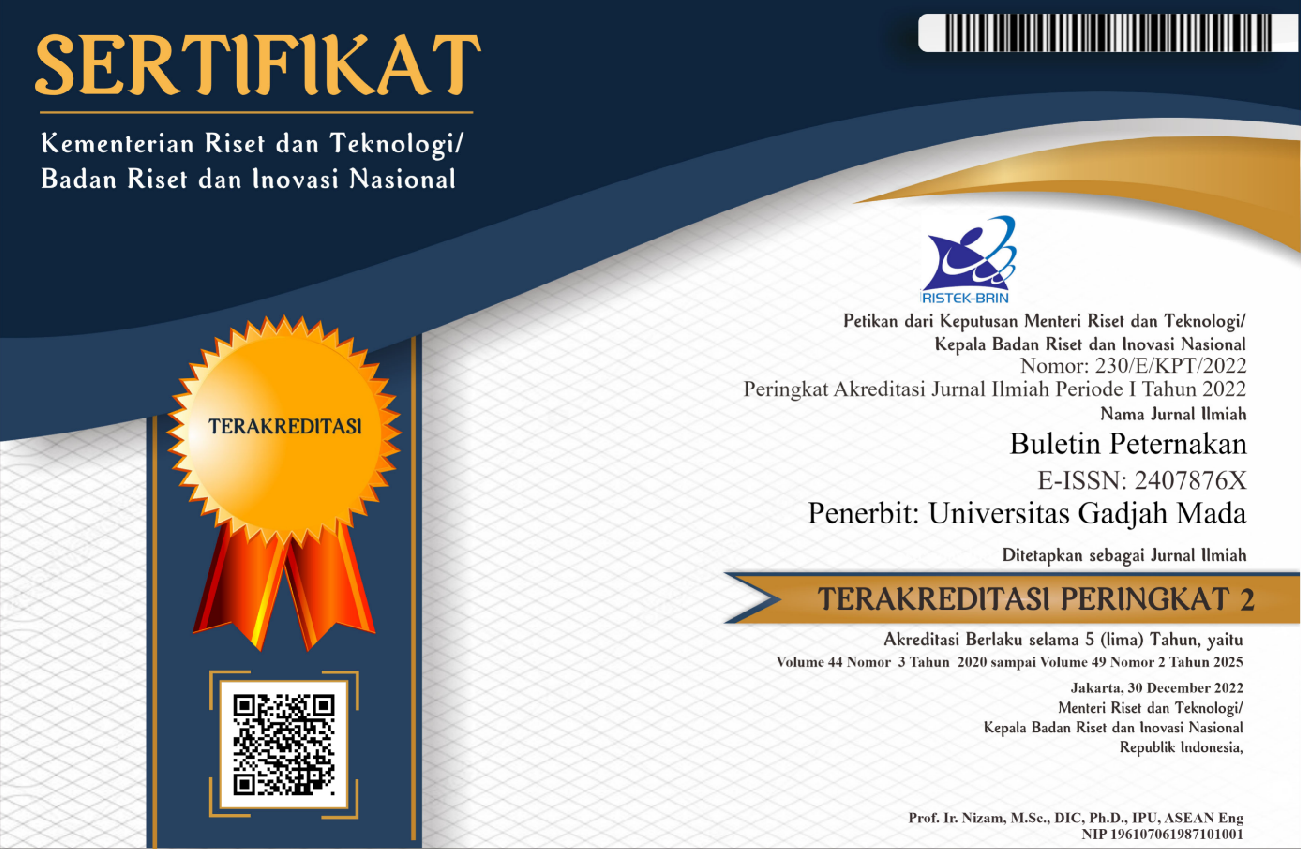Biosorption of Metal Ions on Methanol Dehydrogenase Enzymatic Activity of Bradyrhizobium japonicum USDA110
Novita Kurniawati(1*), Ambar Pertiwiningrum(2), Yuny Erwanto(3), Nanung Agus Fitriyanto(4), Mohammad Zainal Abidin(5)
(1) Universitas Gadjah Mada
(2) Universitas Gadjah Mada
(3) Universitas Gadjah Mada
(4) Universitas Gadjah Mada
(5) Universitas Gadjah Mada
(*) Corresponding Author
Abstract
Keywords
Full Text:
PDFReferences
Abanda-Nkpwatt, D., M. Müsch, J. Tschiersch, M. Boettner, and W. Schwab. 2006. Molecular interaction between Methylobacterium extorquens and seedlings: growth promotion, methanol consumption, and localization of the methanol emission site. J. Exp. Bot. 57: 4025–4032.
Balachandar, D., P. Raja, and S. Sundaram. 2008. Genetic and metabolic diversity of pink-pigmented facultative methylotrophs in phyllosphere of tropical plants. Brazilian J. Microbiol. 39: 68-73. http://doi:10.1590/S1517-838220080001000017.
Cassida, L. E. J. R. 1977. Microbial metabolic activity in soil as measured by dehydrogenase determinations. Appl. Environ. Microbiol. 34: 630-636.
Chistoserdova, L. 2011. Modularity of methylotrophy, revisited. Environ. Microbiol. 13: 2603-22. http://doi: 10.1111/j.1462-2920.2011.02464.x.
Chistoserdova, L. 2016. Lanthanides: New life metals? World J. Microbiol. Biotechnol. 32: 138. http://doi: 10.1007/s11274-016-2088-2.
Day, D. J. and C. Anthony. 1990. Methanol dehydrogenase from Methylobacterium extorquens AM1. Methods Enzymology. 188: 210-216.
Del Rocío Bustillos-Cristales, M., I. Corona-Gutierrez, M. Castañeda-Lucio, C. Águila-Zempoaltécatl, E. Seynos-García, I. Hernández-Lucas, J. Muñoz-Rojas, L. Medina-Aparicio, and L. E. Fuentes-Ramírez. 2017. Culturable facultative methylotrophic bacteria from the cactus Neobuxbaumia macrocephala possess the locus xoxF and consume methanol in the presence of Ce3+ and Ca2+. Microbes and Environments. 32: 244-251. http://doi:10.1264/jsme2.ME17070.
Deleebeeck, N. M., K. A. De Schamphelaere, and C. R. Janssen. 2009. Effects of Mg(2+) and H(+) on the toxicity of Ni(2+) to the unicellular green alga Pseudokirchneriella subcapitata: model development and validation with surface waters. Sci. Total Environ. 407: 1901-14. http://doi: 10.1016/j.scitotenv.2008.11.052.
Delmotte, N., C. Knief, S. Chaffron, G. Innerebner, B. Roschitzki, R. Schlapbach, C. von Mering, and J. A. Vorholt. 2009. Community proteogenomics reveals insights into the physiology of phyllosphere bacteria. Proceedings of the National Academy of Sciences of the United States of America, pp. 16428–16433. http://doi.org/10.1073/pnas.0905240106.
Dourado, M. N., A. Aparecida Camargo Neves, D. S. Santos, and W. L. Araújo. 2015. Biotechnological and agronomic potential of endophytic pink-pigmented methylotrophic Methylobacterium spp. BioMed. Res. Int. 2015: 909016. http://doi:10.1155/2015/909016.
Irvine, I. C., C. A. Brigham, K. N. Suding, and J. B. H. Martiny. 2012. The abundance of pink-pigmented facultative methylotrophs in the root zone of plant species in invaded coastal sage scrub habitat. Badger J.H., (ed). PLoS ONE. 7: e31026. http://doi:10.1371/journal.pone.0031026.
Kaczynka, G., A. Borowik, and J. Wyszkowska. 2015. Soil dehydrogenase as an indicator of the environment with petroleum products. Water Air Soil Polllut 226: 372. http://doi 10.1007/s11270-015-2642-9.
Kalyuzhnaya, M. G., K. R. Hristova, M. E. Lidstrom, and L. Chistoserdova. 2008. Characterization of a novel methanol dehydrogenase in representatives of Burkholderiales: implications for environmental detection of methylotrophy and evidence for convergent evolution. J. Bacteriol. 190: 3817–3823.
Keltjens, J. T., A. Pol, J. Reimann, and H. J. M. Op den Camp. 2014. PQQ-dependent methanol dehydrogenases: rare-earth elements make a difference. Appl. Microbiol. Biotechnol. 98: 6163-83. http://doi: 10.1007/s00253-014-5766-8.
Liu, Q., J. R. Kirchhoff, C. R. Faehnle, R. E. Viola, and R. A. Hudson. 2006. A rapid method for the purification of methanol dehydrogenase from Methylobacterium extorquens. Protein Expr Purif. 46: 316-20. http://DOI 10.1016/j.pep.2005.07.014
Pol, A., T. R. Barends, A. Dietl, A. F. Khadem, J. Eygensteyn, M. S. Jetten, and H. J. M. Op den Camp. 2014. Rare earth metals are essential for methanotrophic life in volcanic mudpots. Environ. Microbiol. 16: 255–264.
Romero-Freire, A., F. J. M Peinado, M. D. Ortiz, and C. A. M. van Gestel. 2015. Influence of soil properties on the bioaccumulation and effects of arsenic in the earthworm Eisenia andrei. Environmental Science and Pollution Research International. 22: 15016-15028. http://doi:10.1007/s11356-015-4659-4.
Saito, A., H. Mitsui, R. Hattori, K. Minamisawa, and T. Hattori. 1998. Slow-growing and oligotrophic soil bacteria phylogenetically close to Bradyrhizobium japonicum. FEMS Micobiology Ecology 25: 277-286.
Schmidt, S., P. Christen, P. Kiefer, and J. A. Vorholt. 2010. Functional investigation of methanol dehydrogenase-like protein XoxF in Methylobacterium extorquens AM1. Microbiology 156: 2575-2586.
Skovran, E., A. D. Palmer, A. M. Rountree, N. M. Good, and M. E. Lidstrom. 2011. XoxF is required for expression of methanol dehydrogenase in methylobacterium extorquens AM1. J. Bacteriology. 193: 6032-6038. http://doi:10.1128/JB.05367-11.
Tyler, G. 2004. Rare earth elements in soil and plant systems—a review. Plant Soil 267: 191–206.
Vu, H. N., G. A. Subuyuj, S. Vijayakumar, N. M. Good, N. C. Martinez-Gomez, and E. Skovran. 2016. Lanthanide-dependent regulation of methanol oxidation systems in Methylobacterium extorquens AM1 and their contribution to methanol growth. Metcalf W.W. (ed). J. Bacteriology 19: 1250-1259. http://doi:10.1128/JB.00937-15.
Article Metrics
Refbacks
- There are currently no refbacks.

This work is licensed under a Creative Commons Attribution-ShareAlike 4.0 International License.
Buletin Peternakan (Bulletin of Animal Science) Indexed by:

This work is licensed under a Creative Commons Attribution-ShareAlike 4.0 International License.










